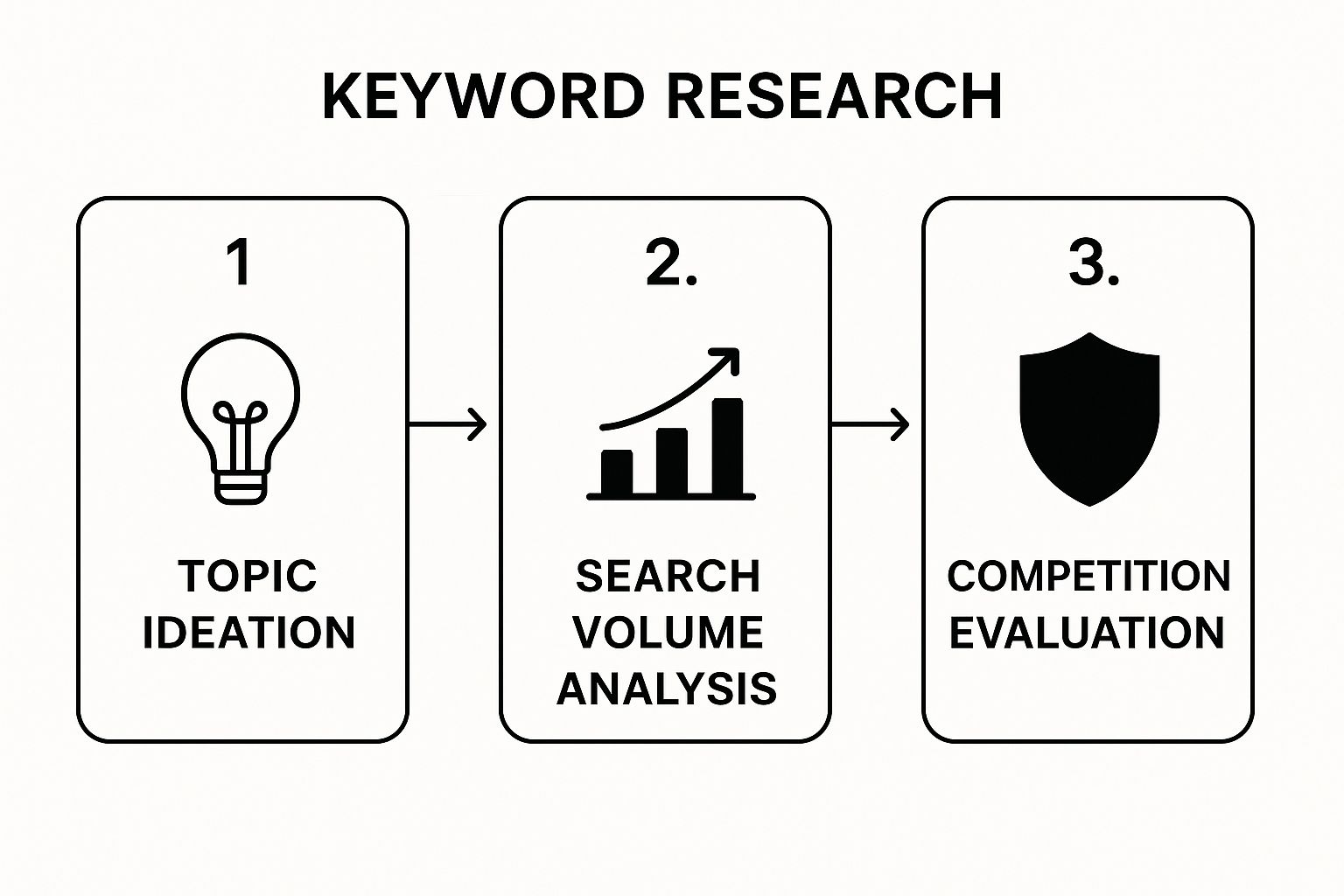Getting to the top of Google isn't just about tweaking a few keywords. It’s a deliberate process of building your site’s authority and proving you have the best answers to your customers' problems. Think of it as earning your spot, not just gaming the system.
Why High Search Rankings Are a Business Imperative
For a B2B SaaS company, showing up on the first page of Google isn't a vanity metric—it’s a direct pipeline to qualified leads. If you’re buried on page two, you’re basically invisible. Your ideal customers are out there right now, searching for solutions, and if they can’t find you, you don't exist.
The jump from page two to the top three spots is massive. Imagine your company sells "project management software for remote teams." Moving from the 12th position to the 3rd could easily double your qualified demo requests. You’re not just getting more traffic; you’re capturing high-intent buyers at the exact moment they’re ready to make a decision.
The Financial Stakes of Top Positions
The drop-off in user attention after the first few results is brutal. A mountain of data shows that 70% of all clicks go to the first five organic results on Google. And since organic search drives 53% of all website traffic, it's by far the biggest game in town.
If you’re not in that top-five club, you're fighting over scraps. It’s that simple. For a deeper dive, you can explore more on these critical SEO statistics to see the full picture.
The truth is, every single spot you climb in the search results exponentially grows your visibility, credibility, and—most importantly—your revenue. This isn't about looking good; it's about measurable growth.
A top-five ranking isn't just a marketing goal; it's a critical business asset. Here's a quick breakdown of why it matters so much.
Why Top 5 Rankings Matter
Securing these top positions consistently pays off, turning your blog into a lead-generation machine that works for you 24/7.
The Four Pillars of a Winning SEO Strategy
So, how do you get there? It comes down to a clear, repeatable strategy built on four core pillars. Get these right, and you're well on your way.
- A Flawless Technical Foundation: Your site needs to be fast, secure, mobile-friendly, and dead simple for Google to crawl and understand. No excuses.
- Problem-Solving Content: You must answer your audience's questions better, clearer, and more thoroughly than anyone else. It's about becoming the resource.
- Authority-Building Links: High-quality backlinks are like votes of confidence from other respected sites. They tell Google you’re a credible, trustworthy source.
- ROI-Driven Measurement: Ditch the vanity metrics. You need to track what actually matters—organic leads, demo requests, and conversions—to prove your SEO efforts are driving real business.
Building Your Technical SEO Foundation
Before you even think about writing killer content, you have to make sure search engine crawlers actually like visiting your website. Think of technical SEO as the foundation of your house—if it's cracked and unstable, everything else you build on top is at risk of collapsing.
This isn’t just about making bots happy. A technically sound site almost always means a better user experience. Things like fast load times and a logical site structure are what convince a visitor to stick around instead of hitting the back button.
This chart really drives home how the whole process starts, from understanding what users want to checking if you can realistically compete.

It’s a good reminder that a winning strategy is built on user intent, validated with real data, and then measured against the competition.
Master Your Core Web Vitals
Google’s Core Web Vitals aren't just suggestions; they’re direct ranking signals that measure a user's real-world experience on your site. Ignoring them is basically telling Google you don't care about your visitors.
There are three big ones to watch:
- Largest Contentful Paint (LCP): How long does it take for the biggest thing on the page (usually an image or a block of text) to load? You need to be under 2.5 seconds.
- First Input Delay (FID): How quickly can a user interact with your page? The goal here is less than 100 milliseconds.
- Cumulative Layout Shift (CLS): Does your page jump around as it loads? This measures visual stability, and you want a score of 0.1 or less.
You can find all this data right inside your Google Search Console under the "Core Web Vitals" report. For B2B SaaS sites, a common LCP killer is an oversized hero image on the homepage or a clunky script that blocks everything else from loading.
Fixing Core Web Vitals isn't just a developer's problem—it's a user experience problem. A slow, clunky site frustrates potential customers before they even get to your value prop.
Create a Clean and Logical URL Structure
Your URLs are one of the first things both users and search engines see. A messy, parameter-filled URL is just confusing noise. On the other hand, a clean, keyword-rich URL gives everyone immediate context.
For instance, this is a terrible URL:your-saas.com/blog/archive/p?id=8271
This is what you're aiming for:your-saas.com/blog/improve-customer-onboarding
See the difference? The second one is intuitive for users and helps search engines understand your site's hierarchy. It’s a small detail, but these small wins are crucial for improving search engine rankings over the long haul.
Guide Crawlers with Sitemaps and Robots.txt
Finally, you need to give search engines a clear map and a set of rules for your site. This is where your sitemap and robots.txt file come into play. They’re your way of telling Google’s crawlers exactly where to go and where not to go.
- XML Sitemap: This is just a list of all the important pages on your site that you want search engines to find and index. Think of it as handing Google a roadmap.
- Robots.txt: This file tells crawlers which pages or sections of your site they should ignore. It’s super useful for blocking things like staging areas, internal search results, or duplicate pages from getting indexed.
A classic example is using your robots.txt to block a URL like /demo-staging/ to keep an unfinished page out of the search results. A smart setup ensures Google spends its time crawling your most valuable pages, not getting lost in the weeds.
Creating Content That Actually Ranks

High search rankings are never a fluke. They’re the direct result of creating content that solves a user's problem better and more clearly than anyone else on the internet. It’s about becoming the definitive resource, not just another post in a sea of look-alike articles.
This means shifting your mindset from just "targeting keywords" to building a library of content that establishes real authority. The goal is to create comprehensive, pillar-style pieces that signal to Google you are an absolute master of your domain.
Embrace Long-Form Pillar Content
Let's be honest: short, superficial articles almost never make a dent in competitive B2B SaaS markets. To truly stand out, you need to go deep. We're talking about long-form content that explores a topic from every important angle. This isn’t about hitting an arbitrary word count; it's about providing complete, satisfying answers.
The data backs this up. By 2025, articles over 2,000 words are far more likely to land in the top ten search results. Why? Because in-depth content naturally aligns with Google's E-E-A-T (Experience, Expertise, Authoritativeness, and Trustworthiness) criteria. It simply offers more value and attracts more high-quality links.
Your content's primary job is to end the user's search. When someone lands on your page, they should feel like they’ve finally found the answer.
This level of depth tells search engines your content is a high-value asset—a cornerstone for improving search engine rankings.
Build Authority with Topic Clusters
A single great article is good. A network of interconnected articles? That's powerful. This is the whole idea behind topic clusters, a content structure that organizes your articles to showcase your expertise on a broad subject.
Here’s what this looks like for a B2B SaaS company:
- Pillar Page: Start with a massive, ultimate guide, like "The Complete Guide to Customer Onboarding." This page covers the core topic broadly and links out to more specific sub-topics.
- Cluster Content: Next, write several supporting articles that dive deep into specific areas mentioned in the pillar. Think: "Best Customer Onboarding Software in 2025," "Creating a Winning Onboarding Checklist," or "How to Reduce Churn with Better Onboarding."
- Internal Linking: This is the glue. Each cluster article links back to the main pillar page. This creates a web of internal links that funnels authority to your most important page and helps search engines map out the relationships between your content.
This structure proves you have more than just a surface-level understanding. You have deep, organized knowledge, making you a trustworthy source for both users and search engines.
Design for Skimmers, Not Readers
Even the most brilliant content will fall flat if it’s a dense wall of text. People don't read online; they scan. Your formatting has to cater to this behavior if you want to keep them on the page.
Think of your formatting as a direct signal of user experience. Good formatting makes information easy to grab. Bad formatting creates friction and sends visitors straight to the back button.
Here are a few non-negotiable formatting rules I live by:
- Use Short Paragraphs: No more than 1-3 sentences. This creates white space and makes your content feel less intimidating.
- Descriptive Subheadings (H3s, H4s): Break your content into logical sections with clear subheadings. This helps readers jump to the exact information they need.
- Bulleted and Numbered Lists: Lists are your best friend for breaking down complex steps, features, or ideas. They are incredibly easy to scan and digest.
- Strategic Bold Text: Emphasize key terms, stats, or takeaways with bold text. This pulls the reader's eye to the most critical points.
By making your content effortless to consume, you improve key user engagement signals like dwell time. For a deeper dive, check out our guide on how to write an SEO-friendly blog post that both readers and search engines will love. This approach ensures your content isn't just found, but actually appreciated.
Using AI to Enhance Your SEO Workflow

AI has officially moved from a conference buzzword to a non-negotiable part of the modern SEO toolkit. For B2B SaaS marketers, this isn't about letting a robot run your strategy. It’s about amplifying it—automating the grunt work and spotting insights you’d otherwise miss.
By bringing AI into your process, you move faster and make smarter, data-backed calls. Forget spending half a day manually clustering keywords or trying to brainstorm fifty different meta descriptions. Delegate it. That frees you and your team up for high-leverage work, like building strategic partnerships or digging into complex user behavior.
This isn't a futuristic idea; it's already happening. Recent data shows 86% of SEO professionals are already using AI tools daily. The big driver is efficiency—75% of marketers use AI to slash time spent on manual tasks, and it's working. Some 65% of businesses are reporting better SEO outcomes as a result. You can find more eye-opening statistics on how AI is shaping SEO right now.
Uncovering Hidden Keyword Opportunities
One of the best uses for AI is finding keywords your competitors are sleeping on. Sure, traditional tools are great for identifying obvious head terms, but AI can dig so much deeper. It uncovers the long-tail keywords and semantic variations that real customers use.
Think beyond basic seed keywords. Feed an AI your customer support tickets, sales call transcripts, or forum discussions. You'll find the exact language your audience uses to describe their problems—a goldmine of high-intent keywords that are way less competitive.
For example, a prompt like this can deliver absolute magic:"Analyze these 50 customer reviews for our project management software. Identify recurring problems and questions, then generate 20 long-tail keywords a potential customer might use when searching for solutions to these specific issues."
This simple shift moves you from guessing what users search for to knowing what they need. That’s how you start seriously improving search engine rankings.
Scaling On-Page Optimization Efforts
Writing unique, optimized meta descriptions and title tags for hundreds of pages is a soul-crushing but critical task. AI can spit out dozens of compelling, character-count-perfect options in seconds. It gives you a solid first draft that you can then polish.
This isn’t about handing over control. It’s about speed. Your human expertise is still essential for adding the brand voice and strategic nuance. But you can get 80% of the way there in a tiny fraction of the time.
AI should be your tireless intern, not your final editor. Use it to handle the grunt work, freeing you up to apply the final layer of strategic polish and creativity that only a human can provide.
Here’s how a B2B SaaS company might put this into practice:
- Meta Descriptions: Generate five versions for a new feature landing page. A/B test them and find the one with the highest click-through rate—fast.
- Image Alt Text: Drop an image into an AI tool and ask it to generate descriptive alt text. You get the accessibility and SEO value without the manual slog.
- Schema Markup: Use an AI assistant to generate the right JSON-LD schema for different content types, like FAQs or product pages, which dramatically cuts down on manual errors.
Conducting Rapid Competitor Analysis
Instead of manually slogging through ten different competitor articles, you can use AI to analyze the top-ranking content and pinpoint gaps. An AI tool can summarize the key themes, pull out common subheadings, and flag topics everyone else missed.
Suddenly, you have a clear roadmap for creating content that's not just different, but demonstrably better and more complete than what's already ranking. When you understand the competitive landscape at this level, you can build a content plan that nails user needs and outsmarts everyone else in the SERPs.
Building Authority with Modern Link Building

You can have a technically perfect website and incredible content, but without one key ingredient, you’ll still struggle to climb the ranks: authority.
Backlinks are the currency of authority on the web. Think of every high-quality link pointing to your site as a vote of confidence. It's a signal to search engines that you’re a credible, trustworthy source. For B2B SaaS, this isn't just a nice-to-have; it's non-negotiable.
Create Link-Worthy Assets
The old "spray and pray" days of link building are long gone. Today, earning high-quality links starts with creating something genuinely worth linking to. You need to develop assets so valuable that other sites want to reference them.
One of the most effective ways to do this is by producing original, data-driven reports. What unique data do you have access to? Could you analyze anonymized user behavior to uncover a surprising industry trend? This is exactly the kind of unique insight that journalists and industry bloggers crave.
The best link building feels less like asking for favors and more like offering a valuable resource. When you create something truly original, the outreach process becomes infinitely easier because you're providing genuine value.
Another powerful approach is to build a free, high-utility tool. If you sell project management software, you could create a "Project ROI Calculator" or a "Team Productivity Grader." These tools solve a real problem for your audience and become natural link magnets.
Find and Claim Unlinked Brand Mentions
Chances are, people are already talking about your company online. They might mention your brand in articles, blog posts, or forums without actually linking back to your website. These unlinked mentions are low-hanging fruit.
Here’s a simple process to turn them into backlinks:
- Set Up Alerts: Use tools like Google Alerts or a brand monitoring platform to track mentions of your company, products, and even key executives.
- Spot the Opportunities: Sift through the results to find mentions that don’t include a hyperlink back to your site.
- Reach Out: Send a polite, friendly email to the site owner or author. Thank them for the mention and gently ask if they’d consider adding a link to make it easier for their readers to find you.
This is one of the easiest link-building wins you can get. The author has already shown they value your brand; you’re just asking them to make it clickable.
Analyze Competitor Backlink Profiles
Why start from scratch when your competitors have already laid out a roadmap? By analyzing where your top competitors get their links, you can uncover a goldmine of replicable opportunities.
Use an SEO tool to pull a backlink report for a few of your main rivals. Look for patterns. Are they frequently featured on specific industry blogs? Do they get links from guest posts, podcast appearances, or software review sites?
This isn’t about stealing their links. It's about understanding which sites are open to linking to companies like yours. Once you find a promising site, figure out how you can offer something even better—maybe a more current statistic, a more comprehensive guide, or a fresh perspective.
Master the Art of Strategic Outreach
Your outreach email is the final, critical step. A generic, templated email will get deleted in seconds. A successful email is personalized, concise, and focused on the value you provide to them.
A simple but effective framework looks like this:
- A Specific Compliment: Show you've actually read their content. Mention a specific point from a recent article that you enjoyed.
- The Value Proposition: Clearly and briefly explain why your resource would be a great addition for their audience.
- The Ask: Make it easy for them. Provide the exact URL and suggest where it might fit.
Platforms like Reddit require a different touch. As our guide on B2B social media marketing strategies explains, genuine participation comes first. You have to build credibility by answering questions and adding value over time. Only then will your contributions be seen as helpful, not spammy.
Measuring SEO Performance That Matters
Executing a brilliant SEO strategy is only half the battle. If you aren't measuring the right things, you’re flying blind—unable to prove your value or figure out what to do next. SEO isn't a one-time project; it's a continuous loop of action, measurement, and refinement that should plug directly into your bottom line.
Forget about vanity metrics like total traffic or impressions. For a B2B SaaS company, the only numbers that truly count are the ones connecting your SEO work to actual business outcomes. It’s time to move beyond broad data and zero in on the key performance indicators (KPIs) that signal real growth.
Focus on Business-Centric KPIs
The whole point is to measure what moves the needle for your business, not just what looks good on a dashboard. Your primary focus should always be on tracking how organic search contributes to the sales pipeline.
Here are the KPIs you should be obsessed with:
- Organic Keyword Rankings for High-Intent Terms: Don't just track your brand name. Monitor your position for problem-aware keywords like "best customer success platform" or "how to reduce SaaS churn." These are the terms that attract buyers, not just browsers.
- Demo Request Conversion Rates from Search: How many visitors who land on your site from organic search actually sign up for a demo? A high ranking is useless if it doesn't lead to qualified leads. This metric directly ties your SEO efforts to sales opportunities.
- Pipeline Generated from Organic Traffic: This is the ultimate proof of ROI. You need to be able to track how many deals that started with an organic search click have entered your sales pipeline and, eventually, how many become closed-won revenue.
Chasing a #1 ranking for a low-intent keyword is a total waste of resources. It's far better to be #3 for a term that generates five qualified demo requests a month than #1 for a term that generates none.
Your Essential SEO Measurement Toolkit
You don't need a dozen expensive tools to get the job done. In fact, two free platforms from Google give you almost everything you need to monitor progress and find new opportunities.
Google Search Console (GSC) is your direct line to Google’s brain. Use it to:
- Spot pages with declining clicks or impressions.
- Find keywords where you rank on page two—these are your low-hanging fruit for quick optimization wins.
- Keep an eye on Core Web Vitals to make sure technical issues aren't holding you back.
Google Analytics 4 (GA4) is where you connect traffic to actual user behavior. Set up custom conversion events to track things like:
- Demo form submissions.
- Free trial sign-ups.
- Ebook or whitepaper downloads.
By analyzing the user journey from a search click all the way to a conversion, you can finally pinpoint which articles and pages are your most valuable sales assets. For a deeper look at this, our guide on essential content marketing metrics can help you build out a full reporting framework.
Establish a Quarterly Audit Rhythm
The search landscape is always changing. A quarterly SEO audit is non-negotiable if you want to keep your strategy agile and responsive. This isn’t some massive technical deep-dive; think of it as a strategic check-in.
During your audit, ask these key questions:
- Which new content pieces are driving the most qualified leads?
- Have any of our core pages lost significant rankings?
- Are there new competitor pages outranking us for our target keywords?
This simple, repeatable process ensures you're always focused on what matters, allowing you to systematically refine your approach and drive sustained growth from organic search.
Common Questions About Improving Rankings
Navigating the world of SEO always brings up the same handful of questions. Let's cut through the noise and tackle the ones that really matter on your way to improving search engine rankings.
How Long Does It Take to See SEO Results?
Ah, the million-dollar question. The honest, no-fluff answer is: it depends. But if you're looking for a ballpark, you should expect to see real, meaningful movement in 3 to 6 months.
Of course, that timeline is pushed and pulled by a few key factors. Your website's current authority, how crowded your keyword space is, and how consistently you show up all play a huge role.
If you're starting with a brand-new site, you're building trust from scratch, so patience is key. On the other hand, an established domain with some existing authority might see gains much faster.
Is It Better to Target High-Volume or Low-Volume Keywords?
Forget volume for a second and focus on search intent. A high-volume keyword might look great on a report, but if it brings in a ton of traffic that never converts, it’s just a vanity metric. It doesn't pay the bills.
My advice? Go after high-intent, long-tail keywords first. Ranking for "project management software for remote construction teams" is infinitely more valuable than ranking for "project management." Why? Because it attracts qualified buyers who are much, much closer to pulling out their credit card.
How Many Backlinks Do I Need to Rank?
This is where everyone gets it wrong. It's not a numbers game. Quality will always, always trump quantity.
A single backlink from a respected industry publication that your ideal customers actually read is worth more than a hundred spammy links from irrelevant directories. Instead of chasing a specific number, focus your energy on earning relevant, authoritative links over time.
Ready to stop guessing and start ranking? PimpMySaaS specializes in building your B2B SaaS authority on platforms like Reddit, driving visibility where it actually matters. See how we can elevate your brand at https://www.pimpmysaas.com.
